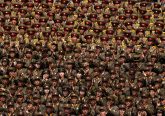 “Until recently having or not having nuclear weapons appeared to be and was treated as a question of yes or no”, wrote Thomas Schelling in a piece called ‘Who Will have The Bomb’, written in 1976 following India’s first use of a ‘peaceful’ nuclear explosive (PNE). “From now on it will make more sense to describe a country’s nuclear-weapons status not with a yes or a no but with a time schedule”.
“Until recently having or not having nuclear weapons appeared to be and was treated as a question of yes or no”, wrote Thomas Schelling in a piece called ‘Who Will have The Bomb’, written in 1976 following India’s first use of a ‘peaceful’ nuclear explosive (PNE). “From now on it will make more sense to describe a country’s nuclear-weapons status not with a yes or a no but with a time schedule”.
When this was written, India’s first PNE was viewed by the international community as a lesson learned; it was clearly an example of sensitive technology and nuclear material for peaceful purposes being diverted towards military use. It was alleged that the Indian test had been carried out using plutonium from the CIRUS reactor (Canada India Research and United States) where the reactor was supplied by Canada and the heavy water (for the reactor) was provided by the United States. Sanctions followed, ending a mere three decades later in 2005 with former U.S. President George Bush and Indian PM Manhoman Singh’s official joint statement for US-India civil nuclear cooperation.
The ’76 test should linger in our memory when it comes to Iran. Of course there are differences. The India-US ‘123’ agreement, as it is known, is by no means anywhere close to the deal that the P5 + 1 (Germany) are offering Iran. However, the numbers 1-2-3 should ring a bell: they might be applied to the Iranian case as symbolic of the 1, 2 and 3 rounds of negotiations in the last two months between Iran and the P5+1, aimed at preventing Iran from developing a weapons program and keeping a check on Iran’s claimed ‘peaceful use’. The third meeting will be held in Moscow this month.
Where are we now? The dominant rhetoric today has changed from a few months ago, when an Israeli strike on Iran’ nuclear facility seemed a highly probable possibility. Now (with the help of sanctions) the rhetoric is about trying to ‘negotiate’ and ‘persuade’, thereby relying on ‘diplomacy’ rather than threats. Sanctions have not only forced Tehran to the negotiating table but have also ensured a commitment to negotiations. This is matched by the domestic rhetoric in Iran. This year, Ayatollah Ali Khamenei claimed that “the Iranian nation has never pursued and will never pursue nuclear weapons”, and linked the issue to religion, stating that “the Islamic Republic, logically, religiously and theoretically, considers the possession of nuclear weapons a grave sin and believes the proliferation of such weapons is senseless, destructive and dangerous”. Hossein Mousavian, the former spokesmen for Iran’s nuclear negotiating team and the author of the forthcoming book, The Iranian Nuclear Crisis: A Memoir, said in a very recent interview with the Carnegie Endowment for International Peace that “definitely there is a much more positive atmosphere…not only in the West…… also within Iranian public opinion and Iranian politicians”.
With this in mind, I think both sides are willing to ‘give and take’ in these negotiations. But the pertinent question is where this giving and taking will happen. What are the possible focal points for a coordinated outcome and how might they be reached? I’ll highlight two such important focal points for a possible deal and discuss how and why these might be achievable.
One such focal point is a ‘smart compromise’. For example, Iran may be asked to stop enriching uranium above 20 percent, the level from which fuel can be used to make weapons. Iran must also agree to ship out its existing stockpile of uranium that has already been enriched up to 20 percent (which Iran claims is for medical isotopes).
In return, this means recognising Iran’s right as a NPT member to continue uranium enrichment up to 3.5 or 5 percent. And the P5+1 will have to provide completed fuel plates, which can be used in the process of making medical isotopes.
All of this is negotiable within the Non-Proliferation Treaty, making it more fair and acceptable to Iran. Agreeing to zero enrichment, a previous demand, was flatly rejected by the Iranians. For Mousavian, “they (i.e. P5+1) have admitted the principle of reciprocity” and Iran itself is more interested in the end-game looking at “the broad package” rather than “a piecemeal approach”.
The second focal point relates to IAEA involvement with Iran’s nuclear sites. Israeli PM Benjamin Netanyahu has publicly demanded that Iran shut down its Fordo Nuclear Plant in a mountain near Qom, a demand that Iran is unlikely to accept. Iran has claimed that the facility is for peaceful purposes and therefore has a right to position its nuclear facility wherever it desires. I agree with Fareed Zakaria who suggests that “Washington should soften its stance on this issue as long as Iran accepts intrusive inspections so it can be independently confirmed that the program is peaceful”. This is possible if Iran agrees to provide IAEA access to its sites. This should increase mutual confidence. Iran seems reluctant to this, but sanctions may tighten the squeeze. Moreover, involving the IAEA legitimises the diplomatic route of P5+1. Mark Hibbs, Ariel (Eli) Levite and Pierre Goldschmidt state in their analysis that the “IAEA track will prove absolutely essential to making the diplomatic track a success, because it will test Iran’s sincerity in reaching an agreement with the six powers (the five permanent members of the Security Council and Germany) negotiating with Tehran”.
Should we be sanguine about this? Relatively. As an NPT member, Iran has a good bilateral relationship with the IAEA, signing a safeguards agreement with it, and it was the IAEA that has acted as a reliable watchdog over Iran’s actions. Keeping the IAEA involved makes any agreement more legitimate. Such an approach can also benefit Iran, providing it leverage in the negotiations due to its willingness to cooperate with the international body.
We will see what happens. One thing is certain: the negotiations in Moscow will come back to arguments over the peaceful use of the atom. But what these negotiations have highlighted thus far is, as Schelling wrote in 1976, that the question of ‘Who will have the Bomb’ can no longer be answered with a simple yes or no. In Iran’s case, it is most likely a no. The problem therefore is two-pronged: the first is how to prevent Iran from getting it, and secondly how to prevent Iran from buying the time to get it. Let’s see where the give and take gets us.
Deepshikha Kumari is a DPhil student in International Relations at Oxford University.





No Comment